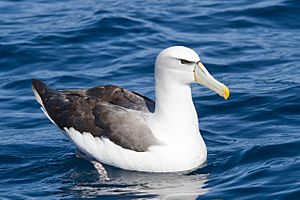Shy albatross facts for kids
Quick facts for kids Shy albatross |
|
|---|---|
 |
|
| Conservation status | |
| Scientific classification | |
| Genus: |
Thalassarche
|
| Species: |
cauta
|
The shy albatross, also known as shy mollymawk, is a medium-sized albatross. It lives for about 60 years. These birds breed on three islands near Tasmania, Australia, in the southern Indian Ocean. You can find them as far away as South Africa and the Pacific coast of the United States.
As of June 2020, the shy albatross is listed as "Endangered" in Australia. Experts believe there are about 15,000 pairs left. It is the only albatross that lives only in Australia. Some people call this bird the white-capped albatross, but that name usually refers to a different type of albatross.
Contents
About the Shy Albatross Family
This type of albatross is a mollymawk. It was once thought to be the same species as the Salvin's albatross and the Chatham albatross. But around 2004, scientists decided they were different species.
Mollymawks are part of the albatross family, called Diomedeidae. This family belongs to a larger group of birds called Procellariiformes. This group includes birds like shearwaters and fulmars.
These birds have special features. Their nostrils are on the sides of their bills. Their bills are also made of several hard plates. They can make a special "stomach oil." This oil is used to feed their chicks and gives adults energy for long flights. It can also be used to spray at predators. They also have a salt gland above their nose. This gland helps them remove salt from their bodies, which they get from drinking ocean water. They get rid of the extra salt through their nose.
What the Shy Albatross Looks Like
The shy albatross is about 90 to 99 centimeters (35 to 39 inches) long. Its wings can spread out to 220 to 256 centimeters (87 to 101 inches). It weighs about 4.1 kilograms (9 pounds). It is one of the largest mollymawks.
This bird is black, white, and slate-grey. It has a black mark under its wing that looks like a thumbprint. Adult birds have a white forehead and a white top of the head. They have a dark eyebrow and a light grey face. Their back, tail, and upper wings are grey-black. The rest of their body is white. Their bill is grey-yellow with a bright yellow top edge and a yellow tip.
Shy Albatross Behaviour
Feeding Habits
The shy albatross finds food by grabbing things from the surface of the water. It can also dive underwater, sometimes as deep as 5 meters (16 feet). They eat fish, cephalopods (like squid), crustacea (like crabs), and tunicates.
Reproduction and Life Cycle
Shy albatrosses build their nests on rocky islands. Their nests are mounds made of soil, grass, and roots. They lay one egg in the second half of September.
Flight Endurance
Some shy albatrosses can fly as far as 1,000 kilometers (620 miles) in just 24 hours!
Where Shy Albatrosses Live
The shy albatross breeds only in Australia. It nests on three islands off Tasmania: Albatross Island, Pedra Branca, and the Mewstone. It is the only albatross that breeds only in Australia.
Young birds have been known to fly all the way to South Africa. Birds that are not breeding can be found across the southern oceans. Sometimes, they are even seen off the Pacific coast of the United States.
Protecting the Shy Albatross
The IUCN says this species is "near threatened." This means it could become endangered soon. In 2007, there were about 25,500 breeding birds.
In the past, these birds were hunted for their feathers. By 1909, there were only 300 pairs left on Albatross Island.
Today, longline fishing is a big problem for them. Birds can get caught on the fishing lines. They have also faced a bird disease outbreak on Albatross Island. Another threat is competition with other seabirds, like the Australasian gannet.
In June 2020, the Australian Government changed the bird's status from "Vulnerable" to "Endangered." This means the bird faces a high risk of dying out. The main threats are climate change and getting caught in fishing nets or on hooks. Diseases and competition with other birds also affect them.
Scientists can only easily watch the birds on Albatross Island. The other two islands are hard to reach.
Images for kids
See also
 In Spanish: Albatros de corona blanca para niños
In Spanish: Albatros de corona blanca para niños




